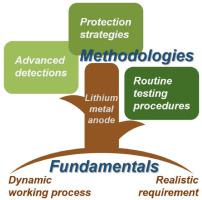EnergyChem ( IF 25.1 ) Pub Date : 2021-09-21 , DOI: 10.1016/j.enchem.2021.100063 Yifang Zhang 1, 2 , Shichao Wu 2 , Quan-Hong Yang 1, 2

|
The concept of a rechargeable lithium metal battery (LMB) was established and commercially realized before the lithium-ion battery (LIB), although safety concerns related to the lithium metal anode (LMA) prevented LMBs from flourishing. As Li-ion chemistry approaches its limitations in meeting the demands of high-energy-density for modern battery technology, research on the LMA has been revived for the production of next-generation Li batteries. With new concepts and technologies being developed and implemented, unprecedented progress has been achieved towards safer and more efficient LMAs, although there are still gaps in putting laboratory-based achievements into real life. This may be caused by the intrinsic shortcomings of the methods and protocols for evaluating LMA, which provide a one-sided perspective and leave key problems unrecognized. This review presents a comprehensive overview of the fundamental problems involved in using LMAs. A dynamic picture of Li metal functioning as an anode is made based on recent knowledge. Realistic requirements for achieving the high-energy-density advantage of LMAs are emphasized. Based on the understanding of these, strategies for Li stabilization are revisited and some overlooked issues need to be addressed.
- •
In this review, we consider the working mechanism of lithium metal anodes (LMAs) with a dynamic picture, including a separate deposition/dissolution process under the influence of spontaneously formed SEI, as well as the repeated cycling along with the evolution of the electrodes.
- •
The requirements for a Li metal anode under realistic conditions are discussed in detail.
- •
Based on a dynamic and realistic perspective, we carefully assess the testing procedures for LMAs and the meaning of the test results. Coulombic inefficiency, or loss of active lithium, is analyzed qualitatively or quantitatively according to the latest understanding.
- •
Finally, we revisit the strategies for LMA protection based on the above discussion and understanding, and highlight some issues that are often overlooked in current research.
中文翻译:

从动态和现实的角度重新审视锂金属负极
可充电锂金属电池 (LMB) 的概念在锂离子电池 (LIB) 之前就已经建立并实现了商业化,尽管与锂金属负极 (LMA) 相关的安全问题阻止了 LMB 的蓬勃发展。随着锂离子化学在满足现代电池技术对高能量密度的需求方面接近其局限性,对 LMA 的研究已经重新兴起,以生产下一代锂电池。随着新概念和技术的开发和实施,在更安全、更高效的 LMA 方面取得了前所未有的进展,尽管将基于实验室的成果转化为现实生活仍有差距。这可能是由于评估 LMA 的方法和协议的内在缺陷造成的,它们提供了片面的视角,并且没有认识到关键问题。本综述全面概述了使用 LMA 所涉及的基本问题。基于最近的知识制作了锂金属作为阳极的动态图片。强调了实现 LMA 高能量密度优势的现实要求。基于对这些的理解,重新审视锂稳定策略,并需要解决一些被忽视的问题。
- •
在这篇综述中,我们考虑了具有动态图片的锂金属负极 (LMA) 的工作机制,包括在自发形成的 SEI 影响下的单独沉积/溶解过程,以及随着电极演变的重复循环。
- •
详细讨论了现实条件下对锂金属负极的要求。
- •
基于动态和现实的视角,我们仔细评估了 LMA 的测试程序和测试结果的含义。库仑效率低下,或活性锂的损失,根据最新的认识进行定性或定量分析。
- •
最后,基于上述讨论和理解,我们重新审视了 LMA 保护的策略,并强调了当前研究中经常被忽视的一些问题。



























 京公网安备 11010802027423号
京公网安备 11010802027423号